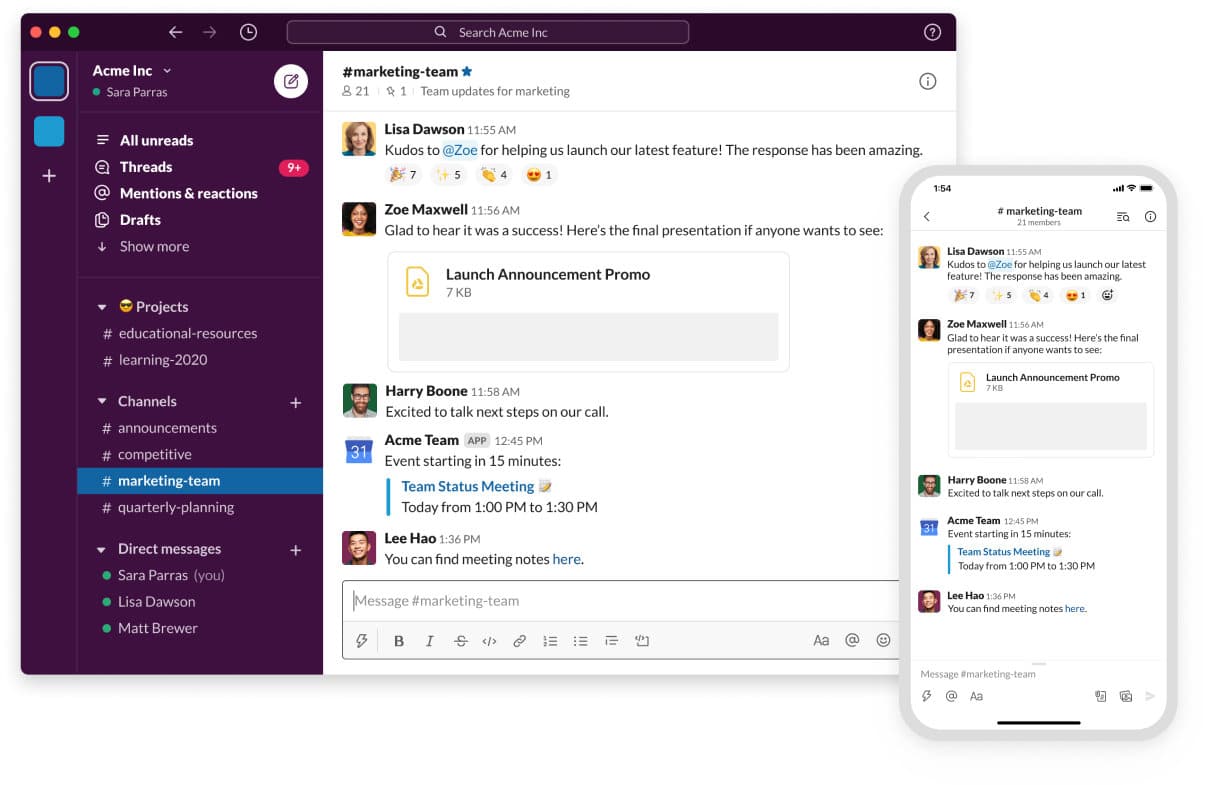
Whether you’re a startup with a small remote team or a large organization with hundreds of workers, it’s essential to understand the significance of having a centralized platform for all communications within your business. Traditional methods like email can often lead to disjointed conversations, slow response times, and difficulty organizing information. In contrast, a centralized platform like Slack ensures faster communication, better organization, and enhanced security.
It allows teams to collaborate seamlessly, making finding and sharing information easier, tracking progress, and improving overall productivity. If you’re considering Slack for your team’s communication needs, exploring its pros and cons is vital to quickly decide whether it’s the right choice for your business.
If you need a full-featured project management tool to work alongside Slack, try AceProject. Its pricing model is not dependent on the number of users, creating considerable savings over time.
Slack – Productivity Platform
Slack is a productivity platform that aims to simplify and enhance work life, making it simpler, more pleasant, and ultimately more productive. It is a digital headquarters where work seamlessly flows between team members, systems, partners, and customers. From small businesses to Fortune 100 companies worldwide, millions of people worldwide rely on Slack to connect their diverse teams, unify communication, and drive their business forward.

With over 200,000 paid customers and 77 Fortune 100 companies using Slack, it has gained a strong reputation and widespread adoption. Its user base spans 150+ countries, with daily active users benefiting from its features and functionalities. It’s trusted by renowned companies such as Airbnb, NASA, Uber, Target, New York Times, and Etsy and has become a go-to productivity platform for businesses of all sizes.
The Cons or Disadvantages of Slack

Slack has quickly become a universal communication tool for businesses and organizations. However, like any technology, it has its downsides. Here are the cons of using Slack and how they can impact teams and individuals.
- Potential for information overload: With its real-time messaging capabilities, Slack can sometimes lead to information overload, as messages and notifications flood the workspace. This can be distracting and affect productivity.
- Dependency on connectivity: Slack heavily relies on an internet connection, making it less suitable for teams working in remote areas or facing network issues. Lack of connectivity can hinder communication and collaboration.
- Learning curve: Slack’s robust features and integrations can be overwhelming for new users. Navigating through channels, threads, and other functionalities may require a learning curve, impacting initial user adoption.
- Reduced focus: Constant notifications and messages can create distractions and hinder deep work. It can be challenging to maintain focus on tasks when there is a continuous influx of communication.
- Security and privacy concerns: While Slack implements security measures, there is always a potential risk of data breaches. Confidential information shared within the platform may be vulnerable to unauthorized access.
The Pros or Advantages of Slack

Slack offers a range of capabilities that make communication easier and more efficient, including messaging, file sharing, and video conferencing. Here, we’ll explore the pros or advantages of using Slack for personal or professional needs.
- Enhanced collaboration: Slack facilitates real-time communication, enabling teams to collaborate seamlessly. Features like instant messaging, file sharing, and threaded conversations streamline teamwork and foster productivity.
- Organized information: Slack provides a centralized platform for discussions, file storage, and knowledge sharing. Messages are organized into channels, making locating information and keeping track of ongoing projects easier.
- Integration capabilities: Slack integrates with many tools and services, allowing teams to bring their workflows together. From project management tools to customer support platforms, integrating with Slack enhances efficiency and eliminates the need to switch between multiple applications.
- Advanced search functionality: Slack’s powerful search feature lets users quickly find relevant conversations, files, and information. This saves time and prevents valuable data from getting lost in a sea of messages.
- Remote collaboration: Slack is an excellent tool for remote teams or distributed organizations. It fosters seamless communication regardless of geographical location, enabling teams to work together effectively and stay connected.
- Customizable notifications: Slack allows users to customize their notification settings, ensuring they receive important updates without being overwhelmed by unnecessary distractions. Users can choose which channels and conversations to prioritize, improving focus and productivity.
Slack Key Features
This section will discuss some of Slack’s key features that make it a go-to platform for team collaboration and productivity. These include:
- Channels: Slack’s channel feature allows users to create dedicated spaces for specific projects, teams, or topics. Channels streamline communication and keep discussions organized, making finding and referencing information easier.
- Threads: Threads enable users to have focused conversations within a channel without interrupting the main discussion. This feature keeps discussions organized and prevents important information from getting lost.
- File sharing and collaboration: Slack allows users to share files, documents, and images directly within the platform. Multiple team members can collaborate on documents in real-time, enhancing productivity and eliminating the need for external file-sharing tools.
- Integrations: Slack offers a vast selection of integrations with popular third-party applications. These integrations allow teams to bring their favorite tools into Slack, creating a centralized hub for all their workflows and increasing efficiency.
- Video and voice calls: Slack provides built-in video and voice calling features, enabling teams to have face-to-face conversations without leaving the platform. This fosters better collaboration, especially for remote teams or when immediate discussion is required.
- Automation and workflow automation: Slack offers automation capabilities through its Workflow Builder tool. Users can create custom workflows and automate repetitive tasks, saving time and improving efficiency.
Slack Use Cases
Slack can be used by teams of all sizes and across various industries. It provides a flexible communication platform that can be tailored to the specific needs of each team. Use cases include:
- Engineering: Slack brings developers, code changes, and tools into one place, facilitating better code collaboration and faster releases.
- IT: IT teams can use Slack to resolve urgent issues, automate workflows, and keep users informed and educated, resulting in faster problem-solving and improved customer satisfaction.
- Customer service: Slack empowers customer service teams by providing access to experts, tools, and information in real time. This enables them to deliver standout customer service and resolve issues promptly.
- Sales: Slack allows sales teams to coordinate with internal teams and work collaboratively towards closing deals with clients. Real-time communication and easy access to information improves the sales process.
- Project management: Slack serves as a central hub for project management, bringing team members, project updates, and task management together. This streamlines project coordination and improves team collaboration.
- Human resources: HR departments can leverage Slack to streamline communication with employees, facilitate onboarding processes, and enhance internal employee engagement.
- Marketing: Slack facilitates collaboration among marketing teams, enabling them to plan campaigns, share content, and track progress in real-time. It promotes efficient marketing workflows and enhances team alignment.
- Security: Slack offers various security features, including data encryption, two-factor authentication, and user access controls. It allows businesses to maintain data privacy and comply with security regulations.
Slack Pricing and Costs
Understanding Slack’s pricing structure can help you determine if it’s the right communication tool for your team. In this article, we’ll break down the different pricing options available:
- Free: The free plan provides basic features and is a great way to try out Slack’s functionality. It allows up to 10,000 searchable messages and supports 1-on-1 video calls.
- Pro: The Pro plan, priced at $3.62 USD per user per month, offers more power and features for small teams. It includes unlimited message archives, group video calls, and advanced user management.
- Business+: Priced at $12.50 USD per user per month, the Business+ plan is designed to scale businesses and increase productivity. It offers additional features such as advanced security controls, compliance exports, and priority support.
- Enterprise Grid: Slack’s Enterprise Grid plan is tailored for large enterprises with specific requirements. It offers custom pricing, providing the flexibility to meet regulatory requirements and scalability to support the organization’s growth.
Recommended article: Slack Pricing Plans.
Conclusion
Trying Slack software can benefit businesses looking to improve their communication and collaboration processes. By understanding the pros and cons outlined in this article, businesses can decide whether Slack is the right productivity platform for their organization. With its extensive features, widespread adoption across different industries, and ability to streamline workflows and enhance teamwork, Slack has proven to be a valuable tool for businesses worldwide.
Peter Kanai is a Google-certified freelance writer with over a decade of experience crafting high-quality content for business websites, blogs, and SEO & email marketing campaigns. His on-demand writing services are all about helping businesses expand their online presence and achieve their objectives. With a proven track record in delivering results-driven content, Peter is the go-to freelance writer for business owners seeking a strategic partner to help them grow their brand online.
This is my first time visit at here and i am genuinely pleassant to read everthing at one place. Slack is a wonderful tool.